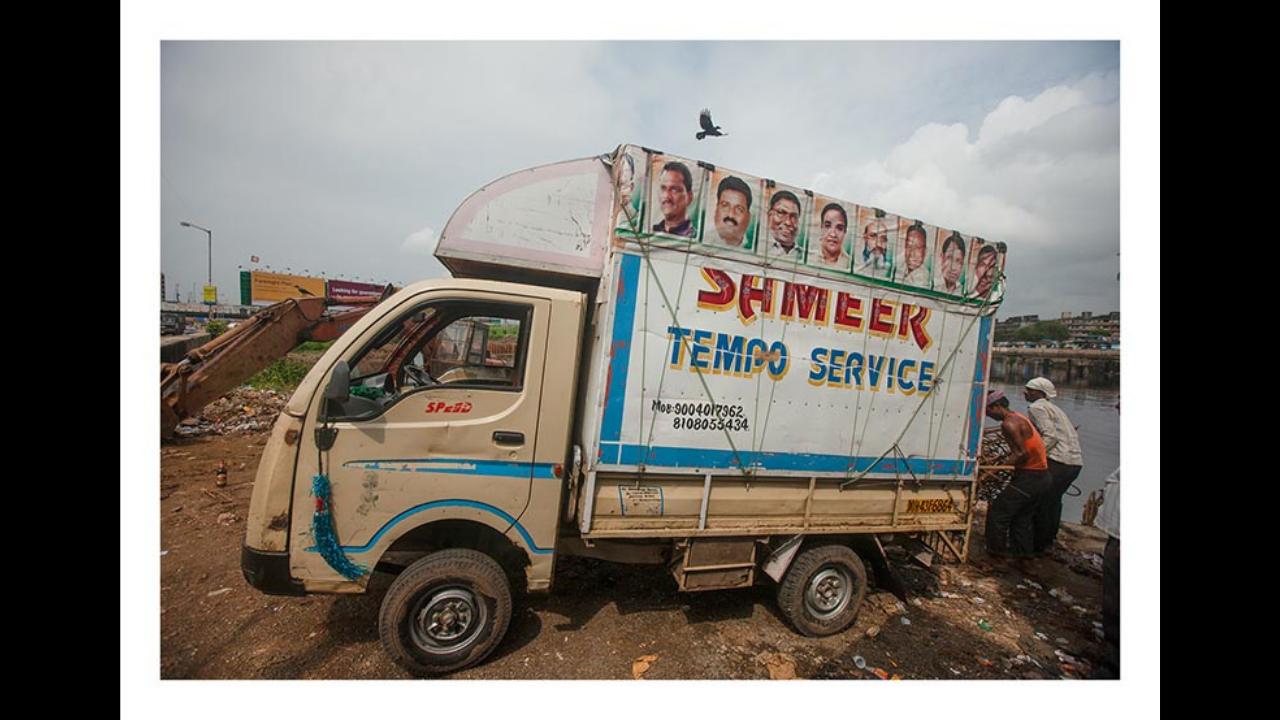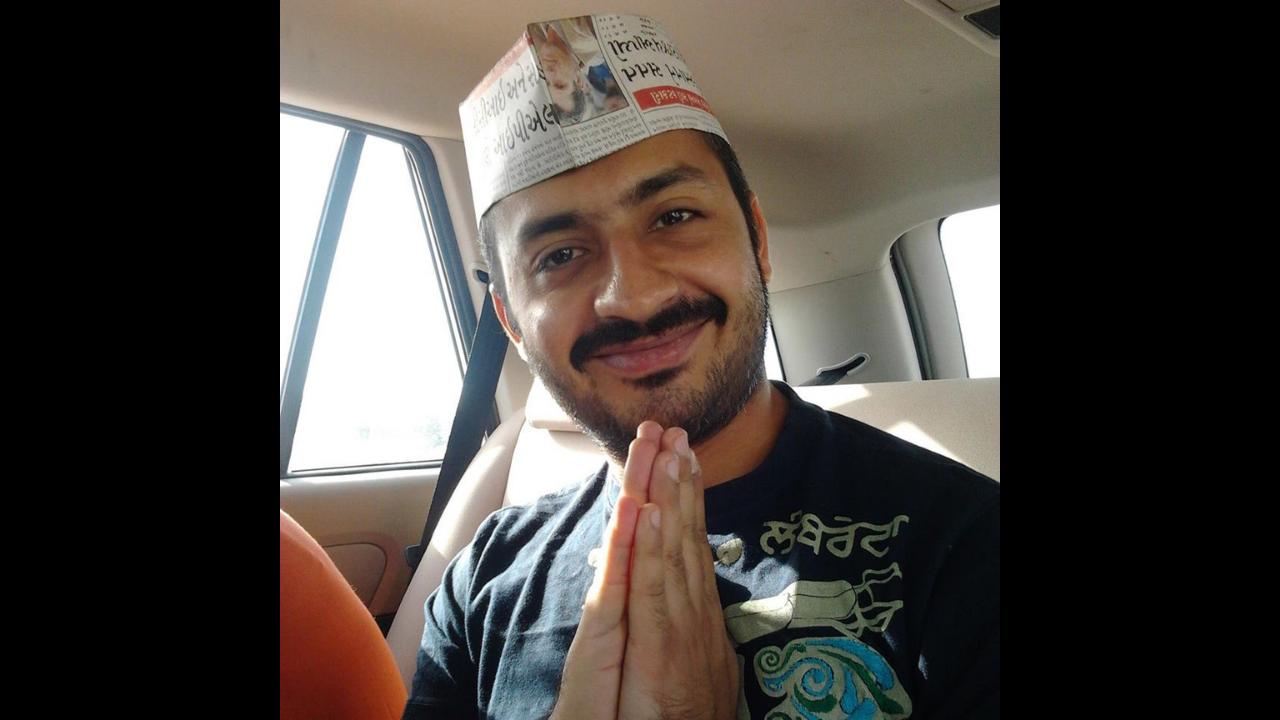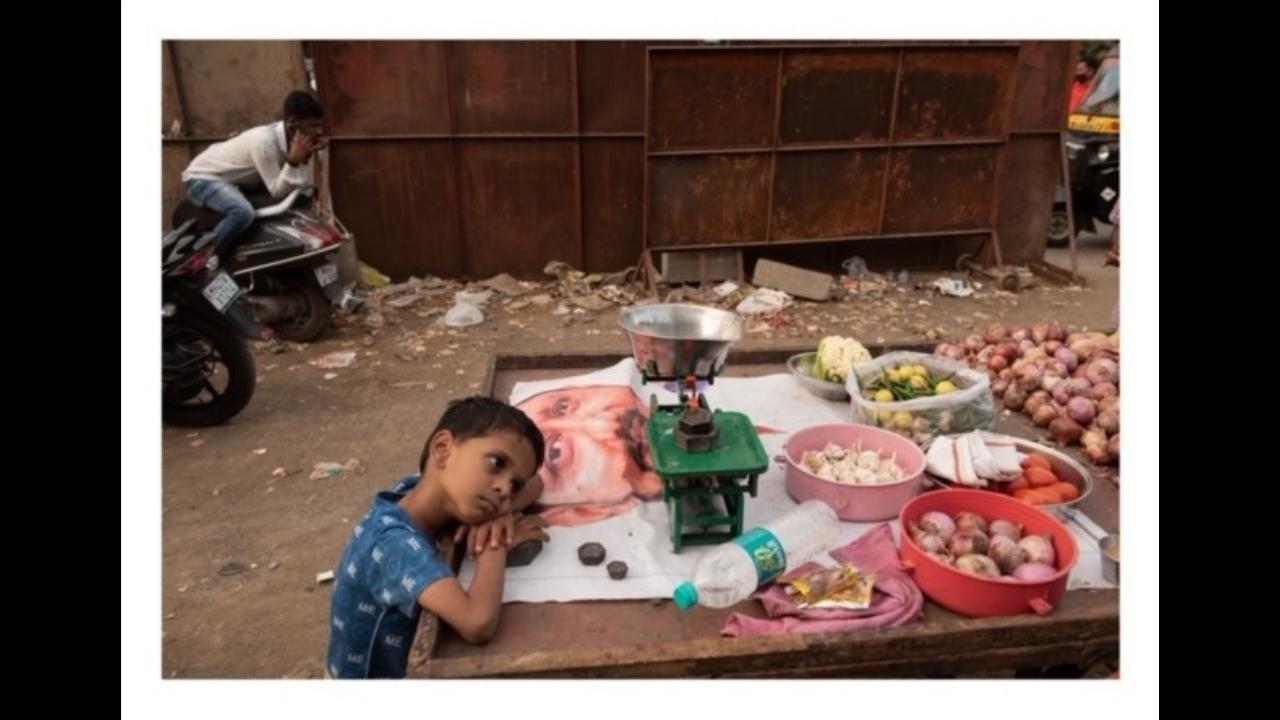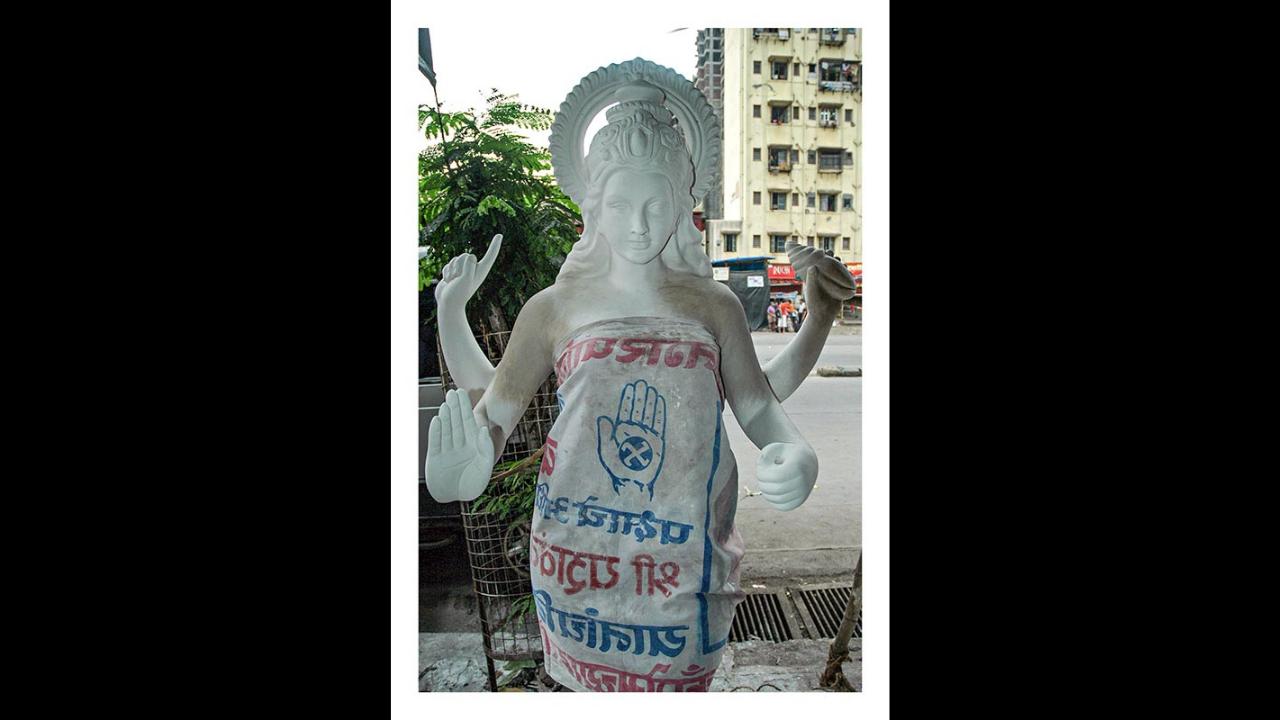Where do the infamous political banners that pop up across the city go to die? Who gets them made in the first place? Mid-day spoke with Mumbai-based Ritesh Uttamchandani who has pointed his camera at these questions for more than 13 years

‘Afterlife’ – his poster series – was shot over 13 years, in the midst of domestic errands and in the pauses between assignments. Photo: Ritesh Uttamchandani
What goes up must come down. After their ceremonial debut on leaders’ birthdays and religious festivals, political banners are often relegated to less flashy roles as makeshift roofs, carpets, waterproofing and packaging material at small neighbourhood businesses.
ADVERTISEMENT
For 13 years, Mumbai-based photographer Ritesh Uttamchandani has paid attention to this lifecycle of such vinyl posters. Their fall from grace, his frames reveal, is also an upswing in purpose: fawning tributes to politicians who push nativist agendas often end up lining the shops of the very migrants they vehemently wanted out of the city.
The photographer and author documents Mumbai in all its poignant and goofy energy. ‘Afterlife’ – his poster series – was shot in the midst of domestic errands and in the pauses between assignments. Among the photographs is a 2004 one of an Indian National Congress banner of the wrapped around the statue of a goddess; another belonging to the Bharatiya Janata Party being peeled off a snack cart it was covering.
The series is currently on show at the Cymroza Art Gallery in his debut solo exhibition, ‘A Lease of Life’, curated by Ranjit Hoskote.
 Photographer Ritesh Uttamchandani documents Mumbai in all its poignant and goofy energy. Photo: Ritesh Uttamchandani
Photographer Ritesh Uttamchandani documents Mumbai in all its poignant and goofy energy. Photo: Ritesh Uttamchandani
Please share the story of how the ‘Afterlife’ series began. When did it start to feel like a series?
I am drawn to the quieter, smaller, peripheral things, which also say a lot about the main things. In the same manner in 2004 I took that photograph of the goddess’ statue which was wrapped with a Congress poster and I didn’t think much of it. I submitted that photograph to the newspaper I was working with and they published it. I also didn’t think of it as a series then, nor did I receive any feedback from any of my peers. But in 2009 when I was with a magazine and I had a fair amount of time, I was referring to my portfolio in search of an old image. I saw this one and thought let me start looking, and once I started looking, I also started finding. It’s like one of those ‘the universe conspires’ kind of clichés. That’s how it started in 2009.
So what is the life cycle of the political poster? And where did your search for its journey take you?
In all honesty the lifecycle is pretty strange. The posters come up when somebody wants to be in good regard with a politician. Let’s assume I am a real estate crony, I am not the builder but a middle man between the builder and politician, etc. Then I will wish the politician on their birthday, there will be 100s of posters littering the street. The same people who install them are in charge of uninstalling. A lot of them go back to the printer. While uninstalling, let’s assume they tear. The BMC takes it to their disposal unit. It’s a cheap and, more or less, free alternative to tarp so they also find their way into multiple usage.
 Photo: Ritesh Uttamchandani
Photo: Ritesh Uttamchandani
Who takes the photographs on these posters? What do you think of the photography featured on the posters?
I know some of the photographers who do these photos. If you look at the design, there is a hierarchy – somebody’s face is bigger, somebody’s face is smaller, some are high res photos, and some are low-res ones that are pixelating. A lot of politicians are visually literate, we think they don’t know but you see them perform when they see the camera. A lot of politicians have mastered the power of images – they know that a single image will travel faster than videos or words. Former and present news photographers and fashion or commercial photographers do this work on the side. The smaller chamchas go to studios or take pictures on their mobile phones. It is a very passport snapshot-ish aesthetic. There is a functional merit to it. I don’t think much of it anyways – I think my opinion of them is clear in my photographs (laughs).
How has your view on posters evolved? Do we need them at all or are they bad news?
I am not a fan of sycophancy. I was told to hold my idols for some time and then abandon them because the more you hold on, your growth is kind of curtailed. I used to like the masters of photography at one time but I kind of moved on. My opinion remains the same: We should not be a country of sycophants and chamchas. So they are obviously bad news. I think it was Kumar Ketkar who said that everyone comes to Bombay with a dream but no one comes with a dream for Bombay.
 Photo: Ritesh Uttamchandani
Photo: Ritesh Uttamchandani
Did you build the series organically during travels or were you setting out deliberately in search of these moments?
I initially used to apply for funding and grants, thinking if I get money I can take some time out to work on the project. When I got time out, there would be domestic errands and this and that. (Grant bodies) have to understand the merit in this work, they have to understand that it has some value. That didn’t really work out. Every time I go out I have a camera, I always have my phone and SLR. But I don’t believe that riyaaz must be done daily. There are lots of factors that need to come together for a person to make a photograph, including something as basic as a good breakfast. I started doing things like leaving early for assignments, loitering after assignments. I would arrive late for drinking plans with friends, they were pissed off but I would show them the image and talk about it with my eyes lit up and they would understand. I have built it organically at my own pace, in my own time. That is only way to do this.
Do you notice all the details in a photograph straight away or are there also surprises in the frame?
There are surprises sometimes, but I cannot rely on surprises all the time. As a practice, I do what I used to read when starting out on a website called photo.net. They had a guide on sports photography which said always take safety shots and then start messing around. In the case of the lead shot of the exhibition, the one with the poster being removed, which is the only one in the series where there is some kind of motion involved – I had gone to buy soap and I saw that a cart was sitting unattended with this poster on it. I took a couple of safety shots and then a crow came and sat. The crow is a theme, an accidental guest, in most of my images. I simply waited and out of the blue some guy came and just pulled off the poster and started setting up the stall for the evening, and I just managed one frame of it. The thing is because I took the safety shot and I was standing and lingering that maybe someone in yellow or a contrasting colour will pass by, that photograph happened. But I also think it is important to go through the evolution where you have surprise elements in the beginning of your career as a photographer.
Are permissions ever a problem when you're taking these pictures?
More than permissions, it's a matter of trust. People usually think I'm from the BMC or I’m from the government and I’m going to take these pictures and I’m going to complain to someone and get them thrown out. Once, the posters were being unwrapped and the boys who install them had to use their feet also. They were worried that ‘if someone sees that my foot is on this person’s face, what will happen’. So there is this odd sort of reverence also which comes from religion and badon ka aadar karna chahiye.
How difficult is it finding new things to say about a city that is so chronicled? Is Mumbai still fun to photograph?
I have this book by Alex Levac, a Israeli street photographer, who says something to the effect of ‘as long as humans are around, there is always something interesting’. The city is always fun to photograph. There is the other school of thought that goes to ‘locations’ like the Gateway, etc but I feel the backgrounds are too imposing there, those places are sitting ducks, and that is no fun. It is very challenging, there is so much grey and beige in the suburbs, there is so much uniformity that is being shoved down our throats as far as town planning and architecture is concerned. For example in Lokhandwala, there is an Arjun statue, there are towers and behind them a sewage line and then this white Arjun statue, which I encountered at 2 am once. Such a bizarre scene, with a heavy level of surrealism in it. And right next to the statue was an empty bottle of wine. It is a subtle image and it demands that the viewer read into what is happening. It talks about the alpha male, drunk on power, which also influences the architecture and demands from the city, or country for that matter. A large portion of the images are shot in the city but they have a larger comment to make.
You said something very interesting about thinking not just in English but in different languages when you're on field. How does that change how you see and what you see?
If you see the aesthetic deployed in the images of the posters, it is not a fine art approach. I find a lot of architectural photography and architectural comment via photography to be very formal and it is all designed to be hung on white walls. This is not. The first photo (of the goddess) I took in 2004 was a quick snapshot, I had limitations of space and time and I was 22. I was formerly drawn to very dramatic images and this was very quiet and slice-of-life. So I allowed that aesthetic to dictate the aesthetic of all the other images post 2009. When you are walking around in a slum cluster or SRA building or engaging with a fruit cart owner, what language do you speak? You speak in Hindi, Marathi, Gujarati. It helps them understand, and it helps me understand the scenario. It influences the way I photograph. When I am buying chana at a food cart, I say ‘dost, kidhar se aaye ho’. It is about how you build relationships and trust and explain what you are doing.
 'A Lease of Life' on display at the Cymroza Art Gallery, Mumbai. Photo: Ritesh Uttamchandani
'A Lease of Life' on display at the Cymroza Art Gallery, Mumbai. Photo: Ritesh Uttamchandani
Why are photography exhibitions few and far between in Mumbai?
Constantly people say ‘oh photojournalism is dead’, ‘photography is dead’, ‘it is moving in another direction’. I don’t think one thing has to die for something else to exist. I think multiple versions of photography can coexist. There is an unspoken demand for a photographer to have AV content as a part of the show. These are things that are too subjective. Some people are like ‘I need better stimulation, these are just photographs’. Well, read the photographs, who is stopping you? Try and peel the layers, try and see what you get out of it. The best way to consume photographs is a book. One can come back to it after 3-4 years also. The deployment of your lived experience again influences the way you read the photographs. What is being done about it? More people should self-publish cheaper books, not your Rs. 3,000-4,000 titles because that ensures your book remains in this rich, elite circle only. Create audiences. We underestimate our audience also, people understand, and draw their meaning. Keep publishing and keep showing. This show has travelled to different audiences – schools, colleges, culture lab, and international photo festivals where it was on streets for people to see; now it is in a white space. The more the work travels to diverse spaces, the more photographers learn. Photography is not going anywhere.
Where will ‘Afterlife’ go from here?
The intention I had was to make a book, what form the book will take, and the production is what I am grappling with now. Because the banners are election-agnostic, I can start, end, pause, and revisit it anytime.
Curator Ranjit Hoskote calls you the “guerilla archivist of the fugitive moment”. What are some other moments that you have chased and documented?
Only somebody who is so deeply clued into the history of art and photography in the subcontinent can come up with that reading of my work. Even I did not know that my work fit into that space. Ranjit’s description of this was spot on. There have been many. I photographed Gay Pride but found that was adding nothing to the visual understanding of the event. Then I started looking at the bystanders there – who are these people who come to gape at the parade? I started noticing that people were looking into other people’s business all the time. In trains, the person sitting opposite me is reading the newspaper and somebody else is peeping into that. They only read the piece that is available to them at that point of time, once the person turns the page, the other also has to move to the next page. I found that very fascinating – the kind of information that is passed through, the kind of dynamic that that is. So I started photographing what I called – ‘the snoops’ – the people who look into other people’s business on trains. That also represents a kind of silent communication between the participants – most of the time unwilling. It becomes a triangle – one person is snooping into another person’s paper and I am snooping into them.
‘A Lease of Life’ is on exhibition in Cymroza Art Gallery till March 9, 2022 from 11 am to 7 pm. It is a pet-friendly show.
 Subscribe today by clicking the link and stay updated with the latest news!" Click here!
Subscribe today by clicking the link and stay updated with the latest news!" Click here!







